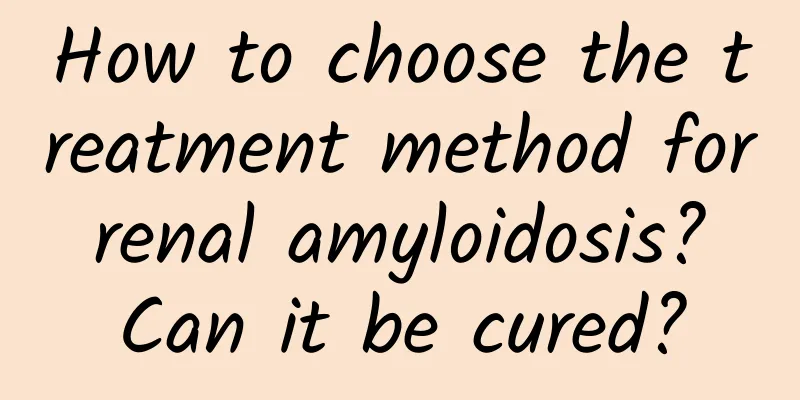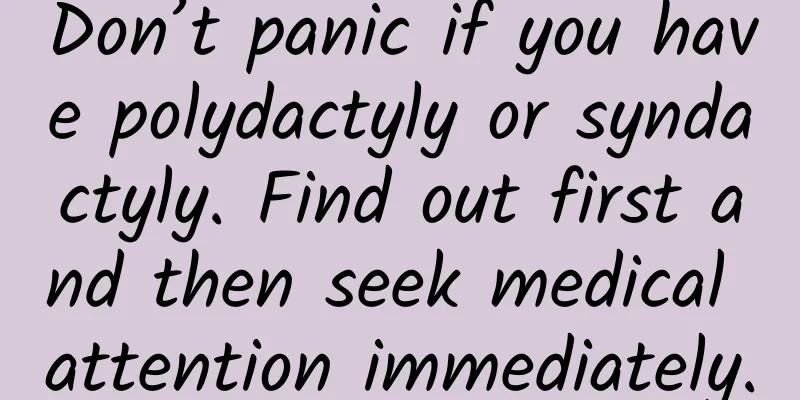How to choose the treatment method for renal amyloidosis? Can it be cured?

|
Author: Liu Gang, Chief Physician, Peking University First Hospital Reviewer: Mao Yonghui, Chief Physician, Beijing Hospital Amyloidosis is a relatively rare disease. There are more than 30 types of proteins that cause amyloidosis. The most common type is the light chain type, or AL type, which accounts for about 90% in our country. AL amyloidosis is a disease in which monoclonal immunoglobulin light chains misfold to form amyloid proteins, which are deposited in tissues and organs and cause tissue structure destruction, organ dysfunction, and are progressive. The kidney is one of the commonly affected organs in amyloidosis. Abnormal amyloid substances are deposited in the kidneys in large quantities, causing abnormal renal function, leading to proteinuria, nephrotic syndrome, and renal insufficiency, which generally occurs in middle-aged and elderly people over 40 years old. Figure 1 Original copyright image, no permission to reprint In recent years, due to the improvement of diagnosis and treatment methods and the discovery of new therapeutic drugs, the survival of patients with renal amyloidosis has been significantly improved. Common treatment options include autologous hematopoietic stem cell transplantation, chemotherapy, immunomodulatory therapy, biological agent therapy, kidney transplantation, etc. 1. Which patients with renal amyloidosis are suitable for autologous hematopoietic stem cell transplantation? First, autologous hematopoietic stem cell transplantation is effective for polyclonal immunoglobulin-related types such as light chain and heavy chain, while other types are not only ineffective but also harmful. At present, autologous hematopoietic stem cell transplantation is the best treatment for light chain amyloidosis. Second, from the perspective of physical condition, the biggest problem is whether the heart is affected. If the heart is already affected and the ventricular wall thickness exceeds 1.3 cm, the mortality rate of autologous hematopoietic stem cell transplantation under such circumstances is very high, and the mortality rate in the transplant chamber is as high as 70%. Therefore, the medical community later unanimously agreed that autologous hematopoietic stem cell transplantation is not recommended for patients with heart involvement and ventricular wall thickness exceeding 1.3 cm. Not only can it not cure the disease, but it will also increase the risk of death. Third, if kidney function is already poor, the risk of autologous hematopoietic stem cell transplantation will be greater. Fourth, age is also a factor. Patients over 70 years old are generally not recommended to undergo autologous hematopoietic stem cell transplantation as it is very risky. 2. Can autologous hematopoietic stem cell transplantation completely cure renal amyloidosis? Theoretically, patients with renal amyloidosis can be cured if they can undergo autologous hematopoietic stem cell transplantation. Because autologous hematopoietic stem cell transplantation will completely clear out the original immune cells, all immune cells and blood cells will be removed, and then the autologous hematopoietic stem cells will be transfused back to grow again. Theoretically speaking, the original clonal plasma cells produced in the body will be killed 100%. Figure 2 Original copyright image, no permission to reprint But this is a theoretical speculation, because during myeloablation, a large dose of chemotherapy drugs is used to kill immune cells and blood cells to the greatest extent, providing space for stem cell implantation. The disadvantage is that it is highly toxic, and the elderly and infirm are often unable to tolerate it, and serious complications often occur. Therefore, the dosage of chemotherapy drugs should be determined based on various factors such as kidney function and age. If the dosage is too large, the side effects are very serious, and the patient may be in danger of death in the transplant chamber. Therefore, the dosage should be selected according to the situation, which is also difficult to master. Although theoretically it is 100% myeloablation, in reality there may still be a small amount of living cells remaining, and the survival ability of tumor cells is still relatively strong, so it may cause recurrence of the disease in the future. In addition, although the blood cells that grow back after the autologous hematopoietic stem cells are transfused are normal, it cannot be ruled out that similar mutations may occur again many years later. Therefore, the 5-year survival rate after autologous hematopoietic stem cell transplantation is generally around 80%, not 100%. 3. Which patients with renal amyloidosis can receive chemotherapy? The most common amyloidosis is the light chain type, whether it is λ or κ. The pathogenesis is the plasma cells that can produce this abnormal monoclonal light chain. It is monoclonal in nature. If it can meet the diagnostic criteria for multiple myeloma, it can be treated directly according to multiple myeloma. If the number of plasma cells is insufficient and does not meet the diagnostic criteria for multiple myeloma, treatment will be based on monoclonal plasma cell disease. You can consider using a chemotherapy regimen based on bortezomib. The more classic one is the BCD chemotherapy regimen, which is basically a combination of bortezomib, cyclophosphamide, and dexamethasone. As long as you can tolerate the side effects of chemotherapy drugs or there are no serious side effects, you must complete the chemotherapy course. According to foreign reports, the chemotherapy regimen with bortezomib as the core can approach the efficacy of autologous hematopoietic stem cell transplantation. If left untreated, the 5-year survival rate is only about 15%, which is the natural prognosis. The 5-year survival rate of chemotherapy according to this regimen can be increased from 15% to 60%. The CD38 monoclonal antibody combined with the BCD regimen developed in recent years can further improve the survival rate. If the patient cannot tolerate the bortezomib chemotherapy regimen and the side effects are too great, the MPT chemotherapy regimen can be considered. This has been proven to be effective in history. It is a chemotherapy regimen with melphalan, prednisone, and thalidomide as the main drugs. The 5-year survival rate can be increased from 15% to 30%-40%. For other types of renal failure, kidney transplantation can be considered, but usually the transplanted kidney will also be redeposited with abnormal proteins, leading to recurrence and recurrent renal failure, and if other organs are affected, it will also bring life risks. For the light-chain type, few patients can reach the stage of dialysis. Usually, the heart is already affected before kidney failure occurs, and they will die from the heart involvement. Therefore, light-chain type patients generally do not undergo kidney transplantation alone. |
<<: What is amyloidosis? What happens if it affects the kidneys?
>>: Does foam in urine mean kidney problems? Not necessarily...
Recommend
When vertigo occurs, what should you pay attention to when using betahistine and in what situations should it not be used?
A friend told Huazi that she had vertigo recently...
Is it normal to have large labia majora?
The labia is an important organ in the female rep...
Can I take medicine when I am 20 days pregnant?
Medical abortion can be performed at 20 days of p...
Can diabetes cause blindness?
Diabetes is a well-known common disease, but diab...
Does breast enhancement underwear really work?
Breast enhancement bras do have a certain effect ...
How does the heart regenerate? After countless brainstorming, I found a "treasure"
Can the human heart regenerate? "Although th...
The family bandaged the wound incorrectly, causing necrosis of the finger of a 3-year-old girl! Please note that bandages should not be used in these cases
Expert in this article: Ao Rongguang, MD, associa...
How many days after sex will you get pregnant?
Nowadays, many young people are unwilling to get ...
What are the risks of sleeping on the right side during late pregnancy?
Compared to ordinary people sleeping on the right...
Do other people really not know that you are lying?
——END—— Produced by/ Efa Written by/ Sijihunhun D...
Two Toes Complaint
Have you ever thought that our toes can also have...
Can I detect pregnancy with a test strip if my period is delayed for three days?
For many couples who are preparing for pregnancy,...
What is a pelvic cystic mass?
The female pelvis is a very sensitive area, and m...
Is it a good thing to dream about snakes when preparing for pregnancy?
Pregnant women dream about a lot of snakes withou...
What is the treatment for fetal intracranial cysts?
If the fetus shows symptoms, it is the most diffi...









